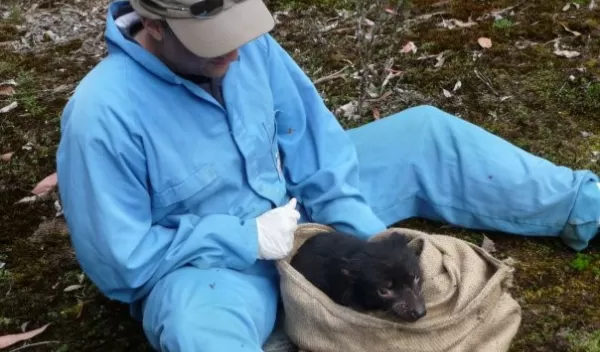
Tasmanian devils may survive their own pandemic
There is some good news about a wildlife pandemic that may also help scientists better understand how other emerging diseases evolve.
Researchers have found strong evidence that a transmissible cancer that has decimated Tasmanian devil populations likely won't spell their doom.
For the first time, a U.S. National Science Foundation-funded team led by Washington State University biologist Andrew Storfer employed the genomic tools of phylodynamics, typically used to track viruses such as influenza and SARS-CoV-2, to trace Tasmanian devil facial tumor disease. The approach has opened the door for applications to other genetically complex pathogens.
The study, published in the journal Science, indicated that the devils' pandemic is shifting from an emerging disease to an endemic one; the disease spread is slowing to the point that each infected devil is infecting only one additional animal or less.
"It is cautiously optimistic good news," said Storfer. "I think we're going to see continued survival of devils at lower numbers and densities than original population sizes, but extinction seems really unlikely even though it was predicted a decade ago."
Since it was first identified in 1996, Tasmanian devil facial tumor disease has reduced populations of the iconic marsupial by 80%. The devils spread the infection when they fight and bite each other on the face.
The disease is still largely fatal to Tasmanian devils who contract it, but it appears to be reaching an equilibrium, according to the study, which confirms evidence from previous field studies. The authors say this new evidence means managers should reconsider the practice of releasing captive-bred devils into the wild.
"Active management may not be necessary and could actually be harmful," Storfer said. "It looks like the devil populations are naturally evolving to tolerate and possibly even resist the cancer. By introducing genetically naïve individuals, they could breed with the wild individuals, basically mixing up the gene pool and making it less well-adapted."
The disease-naïve, captive-bred individuals could also increase transmission of the disease among different groups of devils.
"In addition to good news for Tasmanian devils, this study uncovered information about how infectious diseases spread and evolve, and demonstrates the importance of basic research," said Sam Scheiner, a program director in NSF’s Division of Environmental Biology. "That knowledge will help in the fight against other infectious diseases."


